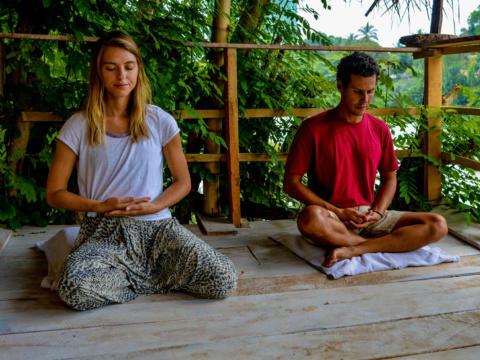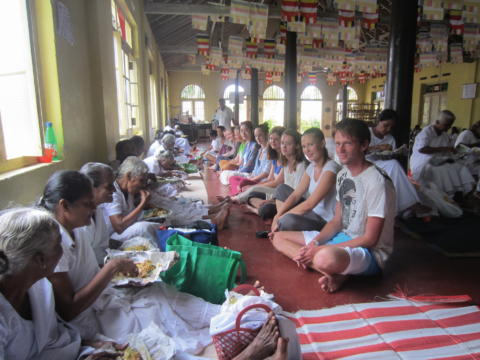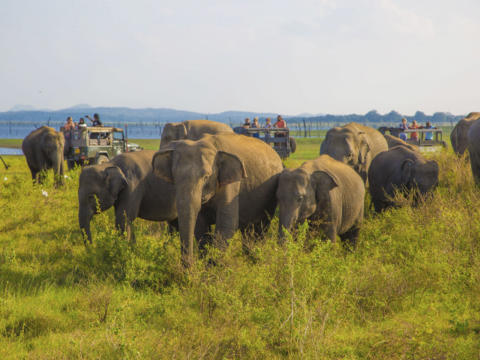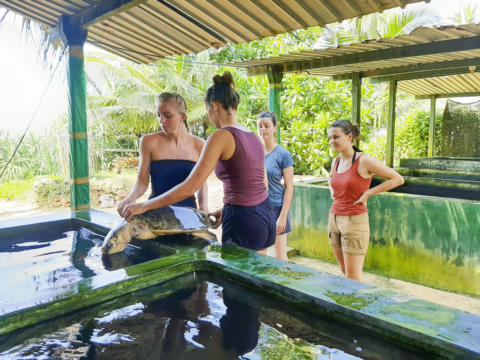Only 270€ per week!
Teaching Project
Hanguranketha - Sri Lanka
Invest your precious time in supporting the underprivileged village kids and the student monks in Hanguranketha.
Under this program, you will be working as a teacher for village kids and monks to help them to improve their English language skills. Most of the students in rural areas in Sri Lanka do not have access to gain proper knowledge of the English language. Therefore, your main role would be to teach them English using fascinating teaching techniques to gain their attention.
Program Description
Preschool Teaching
Your project is to work as an assistant teacher at the village preschool. This program helps children in the villages improve their English language skills. You will primarily be teaching English. You may be called upon to help teach drama and music as well. You will be able to assist other teachers and may have to create teaching plans, etc.
Teaching Monks
This project will be based at a Buddhist temple in a rural area named Hanguranketha where young monks are preparing to propagate Buddhism throughout the world for which they need to learn English. The main goal is to improve the proficiency of spoken and written English among them. You will spend most of your time teaching monks to read and write in English.
The project was started with the intention of increasing proficiency in written and spoken English among Buddhist monks. Over time, we have noticed a vast improvement in the communication skills of the monks. The monks also really enjoy being a part of the program.
Village Kids
Under this program, you will be supporting the village kids who are eager to learn the English language and of course would love to be around you getting exposed to a different culture than theirs. Your main tasks throughout the program would be to teach them the English language, improve their communication skills in English and to build their personality and confidence.
These kids will join you to learn once they come back from their schools. So the typical working hours would be in the afternoon, approximately for 2 – 3 hours. The teaching program will take place at the village temple which is the most convenient place to gather the kids around the village.
Apart from teaching them English, you can also help them with their homework. You also have the freedom to come with various teaching skills and methods through which they can remember what they have learnt easily.
Aims & Objectives
The project aims to give children a good education in order to give them a better and secure future.
Schedule
Monday to Friday
You will be able to choose from three teaching projects depending on the availability at the time.
Preschool Teaching
Your project is to work as an assistant teacher at the village preschool. This program helps children in the villages improve their English language skills. You may be called upon to help teach drama and music as well. You would also assist other teachers and staff and may have to create teaching plans, etc.
Teaching Monks
Since the young Buddhist monks will be attending various functions during the daytime, you will be working at the project for approximately 2 hours per day from around 8.30 to 10.30. You will teach the monks to read and write English and improve their communication skills in English.
Village Kids
In this program, you will conduct classes for children the village which take place in the afternoons. We focus on teaching English to the kids and encourage them to improve their skills in the language. Since this project will be carried out only for 2 to 3 hours in the afternoon, it is suggested that you combine this with another project, which takes place in the morning.
***This schedule can be changed and/or amended depending on weather conditions, local conditions and unforeseen circumstances.***
Note: This schedule can be changed and/or amended depending on weather conditions, local conditions and unforeseen circumstances.
Participant Criteria & Requirements
Standard Requirements
Minimum age: 18
Maximum age: –
Minimum English level: Intermediate
CRB required: On Signup
Passport copy required: On Signup
Resume copy required: No
Required qualification: None
Additional Requirements
- You are required to wear modest clothing that covers your entire body and does not expose any part of the body. Clothing should be preferably white. Light colored clothing of a single color is also acceptable. You will not be allowed to wear footwear inside.
- Participants above the age of 65 should have medical clearance.
Additional Equipment
There are no specific equipment.
Location
Hanguranketha is an ancient city that had been a thriving paddy field in ancient times and was named “Sangaruwan ketha”, later the name changed to the present name Hanguranketha. The city was very useful for the kings of Sri Lanka, especially during the Kandyan period. It was used as the camp city during the troubled period for the kings and the country, due to the south Indian invasions. Many kings had abandoned the royal capital of Kandy in the past and used Hanguranketha as the temporary capital of the island. The city came to being mainly due to the temporary occupation of kings in the past. The city was also known as “Diyatilaka” in the past.
About the Accommodation
You will be accommodated in our center which is located few kilometers away from the town center. There is a beautiful garden to relax in and dining and lounge areas where you can hang out with fellow participants.
Furthermore, there is a refrigerator which you are welcome to use to store food and beverages. Safety lockers are available to store your belongings.
Food Arrangements
You will be provided with three meals a day on weekdays and two meals per day on weekends. The meals are a mix of Western and Sri lankan food, consisting mainly of vegetarian dishes including rice and vegetables.
Facilities
Our house is located few kilometers away from the city center, where you can find anything you might need.
The nearest ATM and supermarket are located a 15 minute walk away from our accommodation.
Activities & Events
No scheduled activities outside the program.
Sights & Surroundings
Gala Uda fortress: Diyatala Kanda is located near the city of Hanguranketha is a well known mountain with historical value. The summit of the mountain commands a panoramic view over the surrounding region.
Potgul Maliga Maha Vihara: This Buddhist temple is one of the most visited religious sites in Hanguranketha. Some of the materials used for the construction are recovered from the Hanguranketha Palace, which was destroyed by the British.
Kitulpe Ranpatge Vihara: This Buddhist temple is one of the several temples that date back to the Anuradhapura (4 BC to 11 AD) period.
Panchanari Getaya: Panchanari Getaya is an example of fine craftsmanship of the ancient Sri Lankan artisans. It is a stone carving depicting five female dancers. This rare piece of stone carving is located near the Vishnu Devala.
Transportation
From this location we do not provide free transport to other locations.
Quick Facts
Name: Democratic Socialist Republic of Sri Lanka
Population: 20 million
Capital: Sri Jayawardenepura Kotte and Colombo
Language: Sinhalese, Tamil
Currency: Sri Lankan Rupee (LKR)
Time zone: UTC +5:30
Country Information
Sri Lanka’s over 2000 years of history and culture can still be seen in every corner of its cities and the details of its ever-beautiful ancient temples. With eight UNESCO World Heritage sites and its short distances between the main sights, Sri Lanka is a country that, despite often being overlooked in itineraries, has left travelers filled with awe.
Visit the sacred home of the world’s oldest living tree in Anuradhapura, wander around the colonial architecture of Colombo, get sun-kissed at the untouched beaches that enclose the territory, snorkel in the crystal-clear waters, head to the hills for a cooler temperature and get surrounded by lush natural vegetation, visit two thousand year-old temples or get overawed at the sight of hundreds of elephants in Minneriya.
While traveling through Sri Lanka you will experience adventures from the highest and chilliest mountains like the famous Adam’s Peak – a stairway mountain considered sacred in three different religions, through the elephant shelters, to the most peaceful beaches up north near Trincomalee and their tiny- one floor- hostels facing the calm sea.
Climate
Sri Lanka is one of the best destinations to visit year-round as the rainy seasons hit the island in opposite locations at different times of the year. That being said, Sri Lanka is a country that can be visited if you know where to go in search for the best weather.
Southwest
The southwest monsoon hits between May and September and the dry season occurs from December to March.
North and coastal regions
The monsoon season happens between October and January while the dry seasons takes places between May and September.
Culture
Sri Lanka is known for its distinct cuisine, indigenous holistic medicines, cricket practices and prestigious export of tea, cinnamon and gemstones. Moreover, the country boasts of a rich artistic tradition which includes music, dance and the visual arts.
Sri Lanka has been shaped by many aspects. The first and most obvious being the heritage of Theravada Buddhism passed on from India. Furthermore, the colonial period left a big mark in the country’s traditions and culture, with British elements being featured in every corner as well as Dutch and Portuguese elements.
Sri Lanka, better known as the “nation of smiling people”, is a paradisiac island that Napoleon described as a world-like biodiversity in a tiny piece of land on the Indian ocean. Multicultural, multi-religious and multi-coloured country, formerly named Ceylon, is known for its delicious black tea, it’s heartwarming inhabitants and its history-filled corners.
The festival of Duruthu celebrates the Buddha’s first visit to Sri Lanka. During Duruthu, thousands of people attend colorful parades, which consist of three processions on the nights before the full moon. The processions consist of fireball performers, drummers, dancers, decorated elephants and the most important – a gigantic tusker treading a white carpet.
On April 13th or 14th Avurudda celebrates the Sinhalese New Year. According to Sinhalese astrology, the new year begins when the sun changes from Meena Rashi (Pisces) to Mesha Rashi (Aries).
During June the Poson Festival takes place on the full moon day of June and celebrates the arrival of Buddhism, which occurred when Arahat Mahinda, the son of the emperor of India, converted King Devanampiyatissa to Buddhism.
During October or November, Diwali the Festival of Lights is celebrated. Diwali is an ancient Hindu festival that signifies the victory of light over darkness, knowledge over ignorance, hope over despair, and good over evil. It is celebrated with millions of lights shining over houses, temples, and buildings. Diwali is celebrated between mid-October and mid-November, on the darkest, new moon night of Karitika.
In Sri Lanka, it is tradition to take an oil bath in the morning, wear new clothes, exchange presents and sweets and visit the Koil, a Hindu Temple. In the evenings, oil lamps are lit to invite the blessings from the goddess of wealth.
Transportation
Plane
Flying between major locations in Sri Lanka such as Galle, Colombo, Nuwara Eliya and others is possible with Aero Lanka and Srilankan Airlines. Moreover, Srilankan Airlines runs small seaplanes, which give you a great aerial view of the island.
Bus
Buses are a option to get around Sri Lanka, albeit quite uncomfortable. For instance, for less than a Euro you can get almost halfway around the island in a bus without air conditioning. Luxury buses with air conditioning also exist at a higher price which are still very inexpensive.
Train
Sri Lanka boasts of an extensive railway system that will get you almost anywhere around the country. Moreover, Sri Lanka is known for its picturesque scenery that can be best viewed in a train journey. In fact, there are observation carts in most trains for tourists that will allow you to better take in the beauty of your surroundings.
In most cases, getting around by train is the cheapest option. There are three classes: 1st, 2nd and 3rd class. In most Intercity and Express trains, however, only 1st and 2nd are offered. Do keep in mind that trains from one popular destination to another (i.e. Colombo – Kandy or Galle – Colombo) often get overbooked, so it is best to reserve a seat much in advance.





